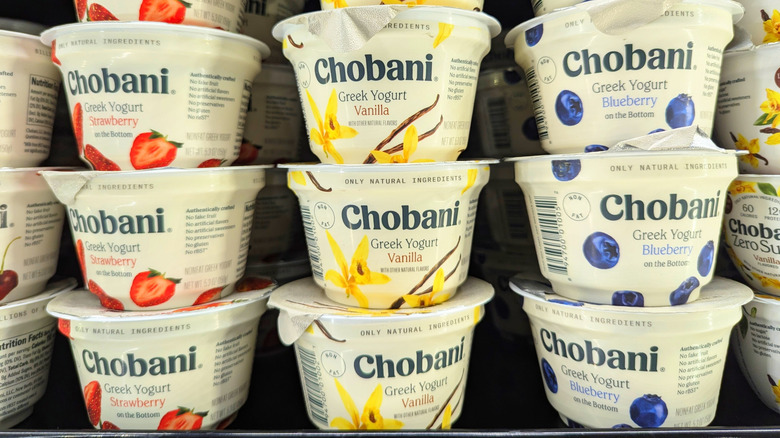Yogurt In Greece Is A Bit Different Than You'd Expect
If you've been traveling this summer, you may have been lucky enough to take an international vacation. While the world is full of wonderful places to visit, one popular destination with a lot to recommend it is Greece. This Mediterranean nation is famous for its ancient ruins, sun-soaked beaches, and olive trees that produce world-renowned olive oil. One other thing that Greece is famous for, to the point that you might have seen references to it at your local grocery store, is yogurt. But visitors to Greece will tell you that yogurt in Greece is a lot more varied, and often not as dense, as the "Greek yogurt" you'll see in American grocery stores.
Now, to state the obvious: while "Greek yogurt" as sold in the United States refers to a particular style of yogurt, all yogurt in Greece is, by default, Greek yogurt. The thick, strained yogurt Americans know as "Greek yogurt" is available in Greece, where it's known as straggisto, but it's only one of a diverse array of yogurt options. In addition to cow's milk yogurt, many people in Greece enjoy yogurt made from sheep and goat's milk, which can have tangier flavors. In rural areas of Greece, there are also many households where people make their own yogurt at home. While flavored yogurts, of any texture, are less popular in Greece than in America, topping plain yogurt, strained or otherwise, with fruit or jam is a classic Greek treat, as it's a tasty way to sweeten up an otherwise plain snack.
How Americans fell in love with Greek-branded yogurt
When most Americans think of "Greek yogurt," they think of the thick, strained, yogurt seen on supermarket shelves under a variety of brand names — despite the fact that, in Greece, this yogurt is one option among many. But how did this come to be? While yogurt has been sold in the United States since the 1940s, so-called Greek yogurt is a relative newcomer, having made its appearance on American grocery shelves in the late 1980s. The first brand to popularize Greek yogurt in the United States was Fage, a company based in Greece, which made explicit for its American customers the connection between their product and Greece. Because the company provided a strained yogurt product and branded it "Greek yogurt," many American consumers assumed that this sort of yogurt was particular to the nation of Greece.
Another brand that popularized Greek yogurt in the United States is Chobani, which, despite the branding, was actually founded by a Turkish man in America. But it wasn't any one brand or combination of brands that made Americans fall in love with thick, strained yogurt. An interest in high-protein foods as a healthy option contributed significantly to the Greek yogurt craze, as did companies' willingness to experiment with different flavors outside of traditional plain yogurt.
Whatever the type of yogurt, there are plenty of ways to enjoy it
Whether you like Greek-inspired yogurt, or prefer a non-strained variation in your probiotic dairy goodness, there's more than one way to get your yogurt fix. While yogurt on its own, perhaps with fruit or cereal, is a great breakfast treat, yogurt isn't just a standalone food item — it's also an ingredient, which can be used for sweet and savory dishes alike.
Strained "Greek" yogurt is popular in Greece itself as the base to make tzatziki, a refreshing, savory dip traditionally made with cucumbers and olive oil. In the United States, the very same yogurt has gone viral as a base for a variation on ranch dressing. Other savory options for plain yogurt can include using it as a marinade ingredient for meat and poultry dishes, or in place of sour cream to top chili, tacos, or baked potatoes. On the other hand, sweet yogurt recipes can include using yogurt when baking a cake for a rich, moist, fluffy result and breakfast breads, or even bagels.


